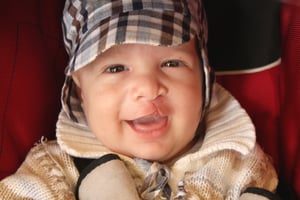 A cleft is any opening in a normally closed structure. A cleft lip is an opening in the lip, typically the upper lip. These clefts are more commonly unilateral (on one side of the lip) as compared to bilateral (on both sides of the lip). Unilateral clefts occur more frequently on the left side of the mouth. A cleft palate is an opening on the roof of the mouth. Clefts can be found in the hard palate (towards the front of the mouth), soft palate (more towards the back of the mouth) or both.
A cleft is any opening in a normally closed structure. A cleft lip is an opening in the lip, typically the upper lip. These clefts are more commonly unilateral (on one side of the lip) as compared to bilateral (on both sides of the lip). Unilateral clefts occur more frequently on the left side of the mouth. A cleft palate is an opening on the roof of the mouth. Clefts can be found in the hard palate (towards the front of the mouth), soft palate (more towards the back of the mouth) or both.
Craniofacial anomalies are abnormalities of the structures of the head and face. There are hundreds of craniofacial anomalies that are associated with communication disorders, with clefts as one of the subtypes. There is no one specific cause for clefts, however most cases are said to be of multifactorial inheritance. This indicates it is due to both genetic predisposition and environmental factors. Clefting is a congenital malformation, meaning it is present at the time of birth. Congenital malformations are the result of disruptions during the embryonic growth process, which consists of the first 7-10 weeks of gestation.
What causes cleft lip or cleft palate?
They are related to a variety of genetic and/or environmental factors.
- Genetic abnormalities
- Chromosomal abnormalities
- Recessive genetic inheritance in some syndromes such as orofacial-digital syndrome
- Autosomal dominant inheritance in some syndromes (e.g. Treacher Collins syndrome, Apert syndrome)
- Environmental factors
- Fetal alcohol syndrome
- Drug use
- Smoking while pregnant
- Some prescription drug side effects
- Positive family history
How is a cleft lip or cleft palate related to speech and language disorders?
- Speech Sound Disorders: can become a significant problem if the palatal cleft is not repaired early on or the repair was not effective. The speech production in a person with a palatal cleft may include obligatory errors and/or compensatory errors.
- Obligatory errors - Exist due to structural abnormalities such as dental deviations or hypernasality
- These are not likely to improve unless there is a structural repair such as surgery.
- Compensatory errors - learned articulation errors that can develop based on the way the child learned to produce speech sounds before a structural repair. That is, the child continues to produce sounds with incorrect placement even after a structural repair that allows for the correct placement is made.
- Obligatory errors - Exist due to structural abnormalities such as dental deviations or hypernasality
- Language Disorders: not as common as speech sound disorders, but can be associated with clefts.
- Expressive language delays Significant language delays in children whose cleft is due to a genetic syndrome
- Voice and Laryngeal Disorders
- Vocal Nodules
- Edema, or swelling, of vocal cords
- Vocal hoarseness
- Resonance disorders (e.g. hypernasality, hyponasality)
How is a Cleft Lip or Cleft Palate Treated?
Children with clefts often work with a variety of disciplines to meet their treatment needs. This team of experts typically includes (but is not limited to) professionals such as an oral surgeon, plastic surgeon, ENT, audiologist, nurse, social worker, and speech-language pathologist. The speech-language pathologists at the Cleveland Hearing & Speech Center (CHSC) can evaluate and recommend treatment options for children with clefts of any type. Speech and language assessments for children with clefts includes a case history, assessment of speech sound production skills, expressive and receptive language skills, vocal quality, and resonance, along with an assessment of oral and facial structure and function. Therapy outcomes will depend on a variety of factors and are unique to each case. The SLPs at CHSC can also refer out to other experts as necessary, and collaborate with these experts on goals and treatment planning.
If you have questions or concerns about your child’s speech development, make an appointment for an evaluation with a Speech-Language Pathologist at Cleveland Hearing & Speech Center.










